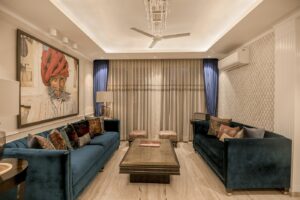The Contemporary Vilas, Gurugram

Strokes of minimalism with colours of indigenous art painted on a canvas of classical architecture
In the evolution of contemporary home design, over the last few decades, a nuclear family and a work-driven lifestyle began to define an Indian home. This novel Indian house in the heart of Gurugram can galvanize such modern Indian families. Rendered with memories and experiences of the user, the design of this home has numerous stories to tell.
The spatial orientation narrates the story of the interior spaces as each transition enhances the journey with altering volumes. Art that reflects the milestones of the client’s journey as a travelling businessman is installed in every nook and corner of the house. A narrow entrance creates an enthusiastic start, which leads to a living room with an attached balcony decorated with vibrant planters and fascinating flooring patterns to augment the experience of the space while bringing nature indoors. Subsequently, the design leads to dining space crafting a lobby that leads to a private lounge room with a television concealing its bedlam from the living room and three bedrooms. The arrangement of micro spaces in bedrooms is a work of art in itself, as the vast volumes are created within a limited area.
The material palette commands the direction of design by amalgamating various styles within a volume. A bespoke brass wall table attached to a classy mirror-panelled wall gives a grand entry by not only augmenting the volumetric experience but also by multiplying it. A proportionate blend of various styles is created within the television room, where a stucco-finished rustic wall is sheathed in white, along with a sealer finished cement board wall, depicting an industrial material palette. The living room is strengthened with the antiquity of Indian décor, which includes marble-tinted wallpaper, that gleams with gold patterns and beaten brass accents that parade the coffee table. The dining room celebrates the luxe of marble, whereas the mirror ornamentation on the wall adds royalty, with each mirror resembling the window of a palace facade. Patterned aqua green wallpaper, and cosy corners enhanced with customised chairs and metal patina hanging lanterns fashion into elegantly designed bedrooms.
As the fusion of styles outlines the journey of spaces, the doors and moulding panels are sculpted in classical curves and true white, as they provide a neutral backdrop for the vibrant jewel tones derived from the rich culture of Rajasthan. Furniture, like the mirror unit in the daughter’s room, is straight out of movie design, customized to anticipate the informality of the space. Exposed columns are square-fluted, as a result of the inspiration from royal palaces of Rajasthan, adding to the fusion by being a part of the composition of the guest lounge.
Paintings suggest excitement as each volume is deliberately highlighted by down lighting to attract focus. A framed sketch of a Baoli in the TV room gently coalesces into the subtle grey walls adding the ancient Indian strokes in the minimal volume. The ‘Red Turban Man’ in the guest lounge, painted by a client’s mother, encompasses the opulence of palace streets complimented by the blue sapphire soft furniture. Pichwai in the dining room is a handcrafted marvel of an artist in Jaipur customised according to the ethos of interiors; as it frivolously rests on the grey wall, the composition of light from the hanging lanterns intensifies the aroma of colour on the mild palette of the room. Complementing the rich jewel tones, a painting of Lord Buddha in the bedroom radiates peace with its antique tones of green and brown. Framed photo albums on every plane not only hold in memories but also induce a retro vibe into the interiors.
Strokes of minimalism with colours of indigenous art painted on a canvas of classical architecture are the apt definition of this masterpiece. The design serves not only to the user but also encourages the immersion of art into architecture while complementing each other. Incorporating extravagance into space without compromising on the functional signification of the intellect of the design language.